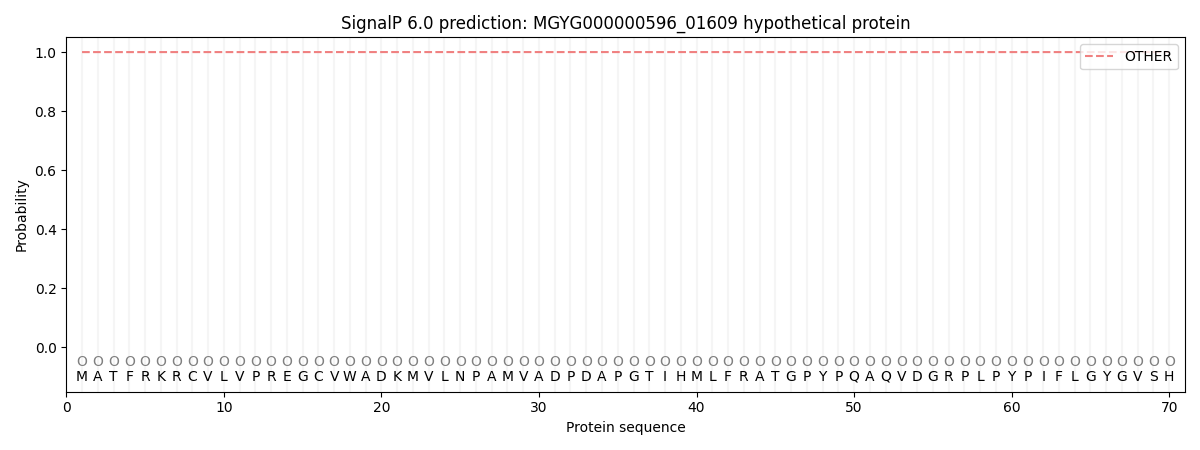You are browsing environment: HUMAN GUT
CAZyme Information: MGYG000000596_01609
You are here: Home > Sequence: MGYG000000596_01609
Basic Information |
Genomic context |
Full Sequence |
Enzyme annotations |
CAZy signature domains |
CDD domains |
CAZyme hits |
PDB hits |
Swiss-Prot hits |
SignalP and Lipop annotations |
TMHMM annotations
Basic Information help
| Species | UBA1724 sp900548225 | |||||||||||
|---|---|---|---|---|---|---|---|---|---|---|---|---|
| Lineage | Bacteria; Verrucomicrobiota; Lentisphaeria; UBA1407; UBA1407; UBA1724; UBA1724 sp900548225 | |||||||||||
| CAZyme ID | MGYG000000596_01609 | |||||||||||
| CAZy Family | GH130 | |||||||||||
| CAZyme Description | hypothetical protein | |||||||||||
| CAZyme Property |
|
|||||||||||
| Genome Property |
|
|||||||||||
| Gene Location | Start: 6869; End: 8029 Strand: - | |||||||||||
CAZyme Signature Domains help
| Family | Start | End | Evalue | family coverage |
|---|---|---|---|---|
| GH130 | 5 | 383 | 9.6e-35 | 0.9695945945945946 |
CDD Domains download full data without filtering help
| Cdd ID | Domain | E-Value | qStart | qEnd | sStart | sEnd | Domain Description |
|---|---|---|---|---|---|---|---|
| cd18614 | GH130 | 5.93e-29 | 18 | 374 | 1 | 271 | Glycosyl hydrolase family 130; uncharacterized. This subfamily contains glycosyl hydrolase family 130 (GH130) proteins, as classified by the carbohydrate-active enzymes database (CAZY), most of which are as yet uncharacterized. GH130 enzymes are phosphorylases and hydrolases for beta-mannosides, and include beta-1,4-mannosylglucose phosphorylase (EC 2.4.1.281), beta-1,4-mannooligosaccharide phosphorylase (EC 2.4.1.319), beta-1,4-mannosyl-N-acetyl-glucosamine phosphorylase (EC 2.4.1.320), beta-1,2-mannobiose phosphorylase (EC 2.4.1.-), beta-1,2-oligomannan phosphorylase (EC 2.4.1.-) and beta-1,2-mannosidase (EC 3.2.1.-). They possess 5-bladed beta-propeller domains similar to families 32, 43, 62, 68, 117 (GH32, GH43, GH62, GH68, GH117). GH130 enzymes are involved in the bacterial utilization of mannans or N-linked glycans. Beta-1,4-mannosylglucose phosphorylase is involved in degradation of beta-1,4-D-mannosyl-N-acetyl-D-glucosamine linkages in the core of N-glycans; it produces alpha-mannose 1-phosphate and glucose from 4-O-beta-D-mannosyl-D-glucose and inorganic phosphate, using a critical catalytic Asp as a proton donor. |
| cd18607 | GH130 | 2.69e-19 | 18 | 374 | 1 | 266 | Glycoside hydrolase family 130. Members of the glycosyl hydrolase family 130, as classified by the carbohydrate-active enzymes database (CAZY), are phosphorylases and hydrolases for beta-mannosides, and include beta-1,4-mannosylglucose phosphorylase (EC 2.4.1.281), beta-1,4-mannooligosaccharide phosphorylase (EC 2.4.1.319), beta-1,4-mannosyl-N-acetyl-glucosamine phosphorylase (EC 2.4.1.320), beta-1,2-mannobiose phosphorylase (EC 2.4.1.-), beta-1,2-oligomannan phosphorylase (EC 2.4.1.-) and beta-1,2-mannosidase (EC 3.2.1.-). They possess 5-bladed beta-propeller domains similar to families 32, 43, 62, 68, 117 (GH32, GH43, GH62, GH68, GH117). GH130 enzymes are involved in the bacterial utilization of mannans or N-linked glycans. Beta-1,4-mannosylglucose phosphorylase is involved in degradation of beta-1,4-D-mannosyl-N-acetyl-D-glucosamine linkages in the core of N-glycans; it produces alpha-mannose 1-phosphate and glucose from 4-O-beta-D-mannosyl-D-glucose and inorganic phosphate, using a critical catalytic Asp as a proton donor. |
| cd18612 | GH130_Lin0857-like | 2.79e-16 | 202 | 378 | 105 | 261 | Glycoside hydrolase family 130 such as Listeria innocua beta-1,2-mannobiose phosphorylase. This subfamily contains the glycosyl hydrolase family 130 (GH130), as classified by the carbohydrate-active enzymes database (CAZY), enzymes that are phosphorylases and hydrolases for beta-mannosides, and includes Listeria innocua beta-1,2-mannobiose phosphorylase (Lin0857). hey possess 5-bladed beta-propeller domains similar to families 32, 43, 62, 68, 117 (GH32, GH43, GH62, GH68, GH117). GH130 enzymes are involved in the bacterial utilization of mannans or N-linked glycans. Structure of Lin0857 shows beta-1,2-mannotriose bound in a U-shape, interacting with a phosphate analog at both ends. Lin0857 has a unique dimer structure connected by a loop, with a significant open-close loop displacement observed for substrate entry. A long loop, which is exclusively present in Lin0857, covers the active site to limit the pocket size. |
| cd08993 | GH130 | 3.21e-16 | 22 | 383 | 5 | 279 | Glycosyl hydrolase family 130. This subfamily contains glycosyl hydrolase family 130 (GH130) proteins, as classified by the carbohydrate-active enzymes database (CAZY), are phosphorylases and hydrolases for beta-mannosides, and include beta-1,4-mannosylglucose phosphorylase (EC 2.4.1.281), beta-1,4-mannooligosaccharide phosphorylase (EC 2.4.1.319), among others that have yet to be characterized. They possess 5-bladed beta-propeller domains similar to families 32, 43, 62, 68, 117 (GH32, GH43, GH62, GH68, GH117). GH130 enzymes are involved in the bacterial utilization of mannans or N-linked glycans. Beta-1,4-mannosylglucose phosphorylase is involved in degradation of beta-1,4-D-mannosyl-N-acetyl-D-glucosamine linkages in the core of N-glycans; it produces alpha-mannose 1-phosphate and glucose from 4-O-beta-D-mannosyl-D-glucose and inorganic phosphate, using a critical catalytic Asp as a proton donor. This family includes Ruminococcus albus 4-O-beta-D-mannosyl-D-glucose phosphorylase (RaMP1) and beta-(1,4)-mannooligosaccharide phosphorylase (RaMP2), enzymes that phosphorolyze beta-mannosidic linkages at the non-reducing ends of their substrates, and have substantially diverse substrate specificity that are determined by three loop regions. |
| COG2152 | COG2152 | 6.42e-16 | 23 | 383 | 31 | 306 | Predicted glycosyl hydrolase, GH43/DUF377 family [Carbohydrate transport and metabolism]. |
CAZyme Hits help
| Hit ID | E-Value | Query Start | Query End | Hit Start | Hit End |
|---|---|---|---|---|---|
| AIQ48603.1 | 4.30e-127 | 10 | 383 | 13 | 394 |
| AIQ54089.1 | 9.89e-126 | 10 | 383 | 13 | 394 |
| AFC29517.1 | 3.49e-125 | 9 | 383 | 12 | 392 |
| AEI40935.1 | 3.49e-125 | 9 | 383 | 12 | 392 |
| AFH61696.1 | 1.41e-124 | 9 | 383 | 12 | 392 |
Swiss-Prot Hits help
SignalP and Lipop Annotations help
This protein is predicted as OTHER

| Other | SP_Sec_SPI | LIPO_Sec_SPII | TAT_Tat_SPI | TATLIP_Sec_SPII | PILIN_Sec_SPIII |
|---|---|---|---|---|---|
| 1.000069 | 0.000000 | 0.000000 | 0.000000 | 0.000000 | 0.000000 |
